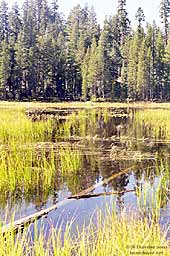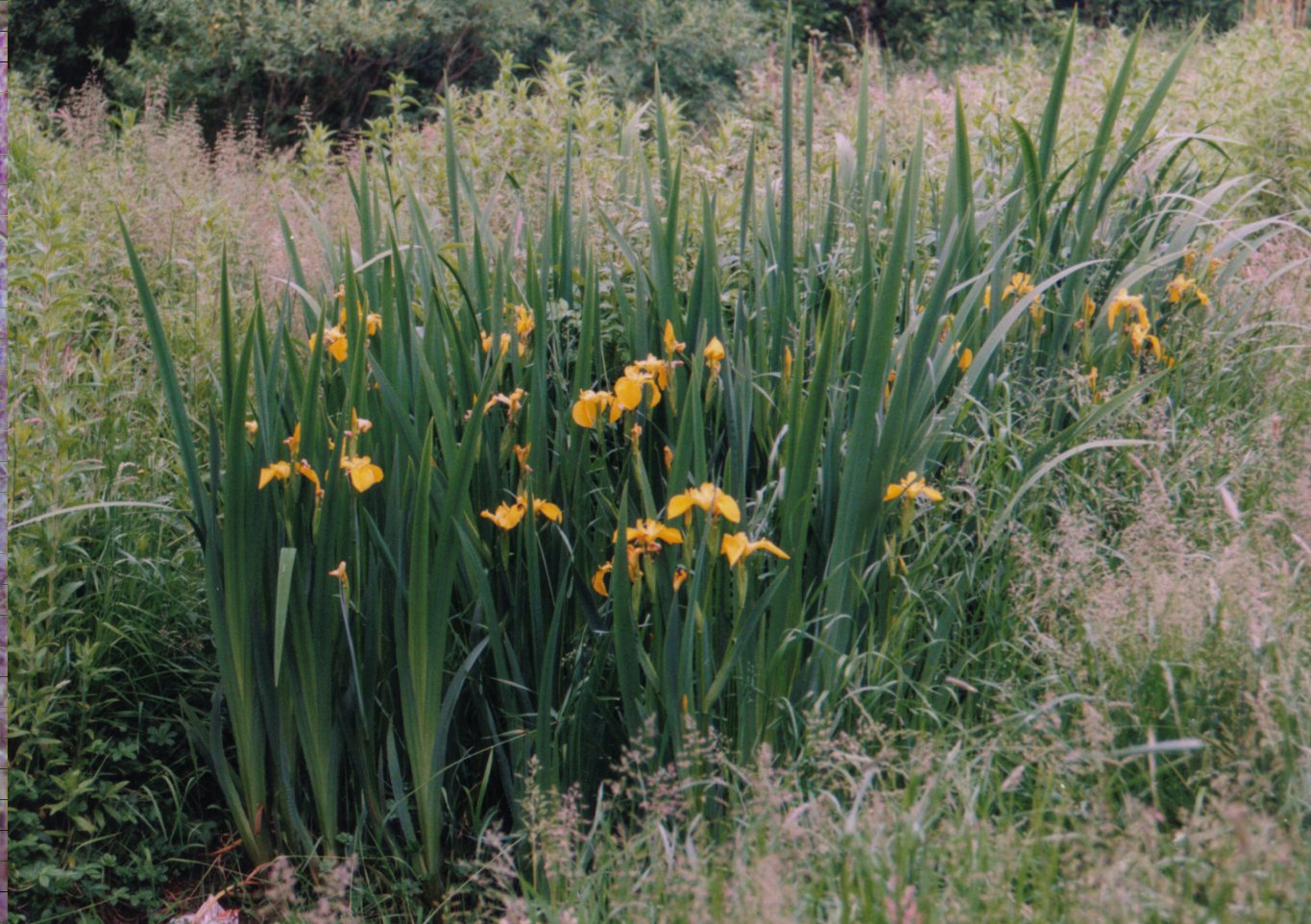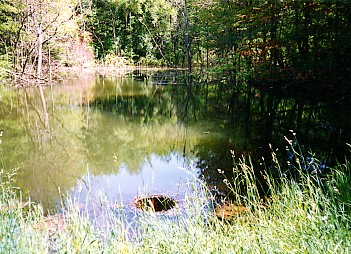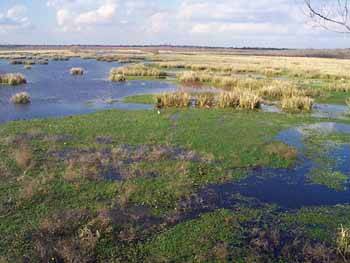In Your Backyard A mini-wetland in your yard can provide many of the same benefits that natural wetlands offer. A mini-wetland can replace the important natural functions of wetlands that may have been lost when your community was developed.
A wetland in your backyard will temporarily store, filter, and clean runoff water from your roof and lawn. It will provide habitat for many interesting creatures--from butterflies and bees to salamanders, toads, frogs, and birds.
Most wetland plants do not require standing water to grow successfully, and will survive even in an area that appears dry during most of the growing season.
If you have a naturally occurring wet spot in your yard, or a low swale or drainageway with heavy clay soils, you easily can turn it into a wetland paradise. Even if you do not have a naturally wet spot, you can establish an area in your yard to grow many of the beautiful plants associated with wetlands.
What is a Wetland? 
A wetland is simply any area where water covers the soil or keeps it saturated for at least two or three weeks during the growing season. You will usually find them anywhere water accumulates at a rate faster than it drains away. Some are inundated year-round while others only hold water for brief periods in the spring. Most wetlands are covered with water for less than a month during the summer. Wetlands dominated by grasses, cattails, and similar herbaceous vegetation are referred to as marshes, while wooded wetlands, dominated by shrubs and trees, are called swamps.The saturation of the soil limits the types of plants you can grow to those with "wet feet." How long the soil is saturated determines which wetland plants will grow best. There are many small wetland plants that grow quickly when the soil is wet in the spring and disappear when the soil dries up. Species like cattails, bulrushes, jewelweed, and the attractive cardinal flower do well where there are alternating wet and dry periods. These plants will survive persistent flooding as long as most of the leaves are out of the water. Water lilies and pond weeds grow well in permanently flooded ponds.

In your backyard, toads and tree frogs (spring peepers) will lay eggs and the pollywogs will mature where water only lasts 3 or 4 weeks; other frogs need longer periods. Where you have permanent water, the bullfrog pollywogs and small fish eliminate reproduction of most other frogs, toads, and salamanders. Mosquitoes will not survive in wetlands that dry out in less than a week after a summer rain or in wetlands connected to a deeper pond that supports small fish and large aquatic insects that feast on them.
Where to Put a Wetland 
A natural depression or ditch that tends to stay wet is an ideal place to develop a wetland. Other areas with heavy clay soils that drain slowly may also be suitable. Better drained sites may require use of a plastic or other type of liner. Of course, if you are building a backyard pond a shallow area of saturated soil can be incorporated in the design. When selecting a site, consider:Is the site away from your foundation, out buildings, existing landscaping that you want to maintain, or neighboring properties that might be damaged by excessive moisture? Would there be a safety concern for neighborhood children? How will the site be integrated into your plan for maintenance? If you need supplemental water, is it readily available or can you use roof drainage? If there is an existing wetland, check state and local wetland regulations before altering it. Unless you completely own a ditch, check with local authorities before making any alterations. Be sure you won't cause adjacent properties to flood.
Building a Wetland Since wetlands refer to a variety of conditions, there is a lot of potential for including wetland plants in your yard. You may want a wetland that only stays wet for a short period after heavy rains or one that stays wet most of the time. It depends on the site and your desires. Establishing a wetland in your yard may be as simple as planting wetland plants in an existing wet area, or it may require the same effort needed to install a backyard pond.
Building a Wetland in an Existing Wet Area or Rainageway In some instances, all you need to do is stop mowing during dry periods. Too often homeowners go to great lengths to establish plants that are not adapted to the site or to modify the site, when it would be more effective to use plants suited to the conditions. Numerous landscape plants are well adapted to wet conditions and will provide beauty as well as wildlife habitat. Be sure to check the growth and rooting characteristics of trees you want to plant. Many wet soil tolerant trees have shallow root systems or brittle branches and must be planted a safe distance from buildings.
Partially blocking a drainageway or small ditch to create your wetland by trapping storm water needs more planning. Where a low berm less than a foot high will create a small wetland, planning is not complicated if:
1. The drainage area above the berm is small, generally less than an acre 2. There is adequate area for flood flows to go around and over the berm 3. The soil contains a high percentage of clay. For sites requiring a higher berm, and those with a larger watershed, you need engineering advice. For sites with sandy soil or a lot of rocks, you also may need to install a plastic liner under all or the lower portion of your wetland.
To construct the wetland with a small berm to hold back water for a few days or weeks:
1. Put a stake in the center of the lowest portion of the drainageway where you want the berm. 2. Using a level on a large board or string, place a stake where a level line reaches the ground on either side. 3. Using the same type of level, mark how far back water will be impounded at the top of the berm.

4. Remove any existing sod from an area about 4 feet wide along the line of the berm and over about half the area that will be flooded. 5. Dig a trench about 1 foot deep along the center line of the berm and fill it with slightly damp heavy soil, packed down firmly. 6. Build your berm about 4 feet wide at the bottom and 1 foot at the top. The center should be 4 to 6 inches higher than the ends to allow for settling and to force water flowing over it around the ends, reducing the likelihood of erosion. 7. Cover the compacted berm with purchased grass sod or the sod you originally removed from the area. 8. Plant wetland adapted plants in bands from the deepest areas to an area about six inches above the expected high water level, selected according to the degree of soil saturation they require.

